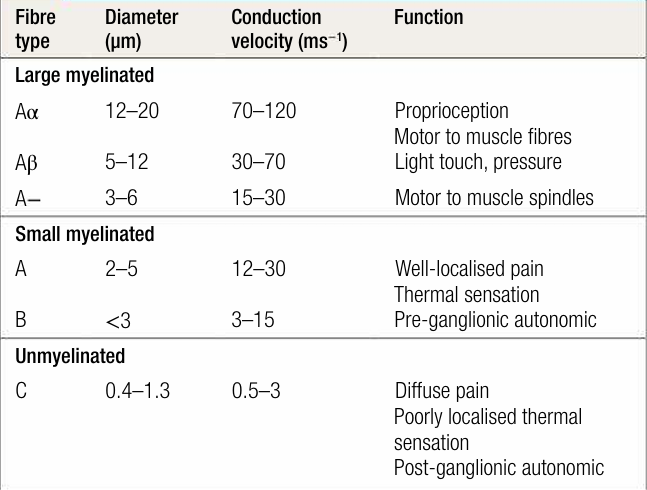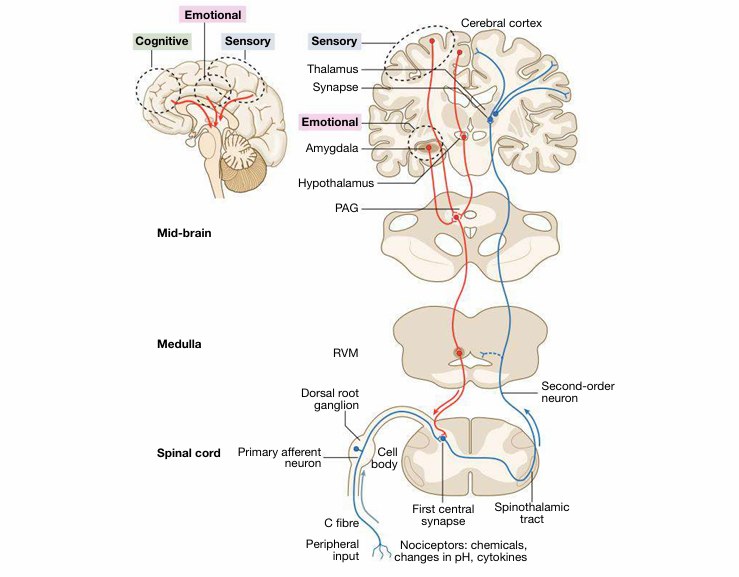
Peripheral nerves
 المؤلف:
Stuart H. Ralston , Ian D Penman, Mark W J Strachan , Richard Hobson
المؤلف:
Stuart H. Ralston , Ian D Penman, Mark W J Strachan , Richard Hobson
 المصدر:
Davidsons Principles and Practice of Medicine
المصدر:
Davidsons Principles and Practice of Medicine
 الجزء والصفحة:
24th Edition , p156-157
الجزء والصفحة:
24th Edition , p156-157
 2025-02-15
2025-02-15
 823
823
Peripheral nerves contain several types of neuron. These can be classified into two groups, depending on whether or not they are surrounded by a myelin sheath. Myelinated neurons have a fast conduction velocity and are responsible for transmission of various sensory signals, such as proprioception, light touch, heat and cold, and the detection of localised pains, such as pin-prick. Unmyelinated fibres have a much slower con duction velocity and are responsible for transmitting diffuse and poorly localised pain, as well as other sensations (Box 1).

Box1. Types of nerve fibre
Sensory neurons (also known as primary afferent neurons) connect the spinal cord to the periphery and supply a defined territory or a dermatome, which can be used to identify the position of a nerve lesion ( Fig. 1). In healthy individuals, dermatomes have distinct borders, but in pathological pain syndromes these may become blurred as the result of neuronal plasticity, which means that pain may be felt in an area adjacent to that supplied by a specific nerve root. Autonomic neurons also contain pain fibres and are responsible for transmitting visceral sensations, such as colic. In general, visceral pain is diffuse and less well localised than pain transmitted by sensory neurons.

fig1. The areas supplied by specific levels of the spinal cord.
Anatomical features of the afferent pain pathway are illustrated in Figure 2. Pain signals are transmitted from the periphery to the spinal cord by sensory neurons. These have the following components:
- A cell body, containing the nucleus, which is situated in the dorsal root ganglion close to the spinal cord. The cell body is essential for survival of the neuron, production of neurotransmitters and neuronal function.
- The nerve fibre (axon) and peripheral nerve endings, which are located in the periphery and contain a range of receptors in the neuronal membrane.
- Specialised receptors in the periphery, consisting of bare nerve endings known as nociceptors or pain receptors, which are activated by various mediators. They are situated mainly in the epidermis.
- The central termination, which travels to the dorsal horn of the spinal cord to form the first central synapse with neurons that transmit pain sensation to the brain.
When a noxious stimulus is encountered, activation of nociceptors leads to generation of an action potential, which travels upwards to the dorsal root ganglion and also stimulates the release of neurotransmitters that have secondary effects on surrounding neurons.

fig2. Ascending and descending pain pathways.
 الاكثر قراءة في الجهاز العصبي
الاكثر قراءة في الجهاز العصبي
 اخر الاخبار
اخر الاخبار
اخبار العتبة العباسية المقدسة


